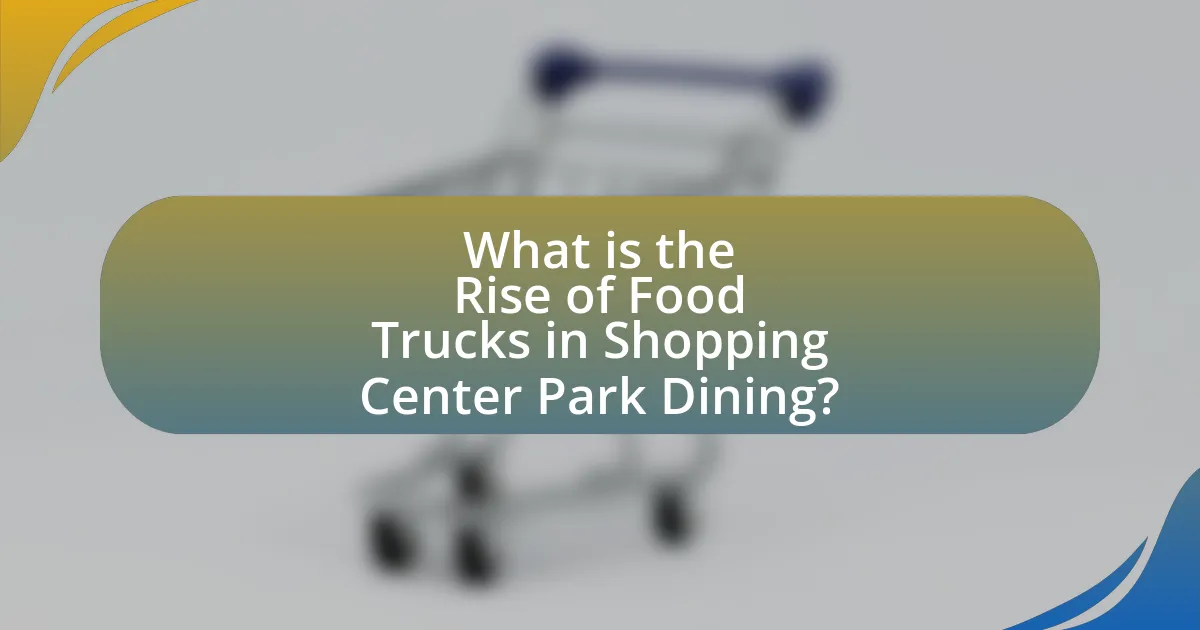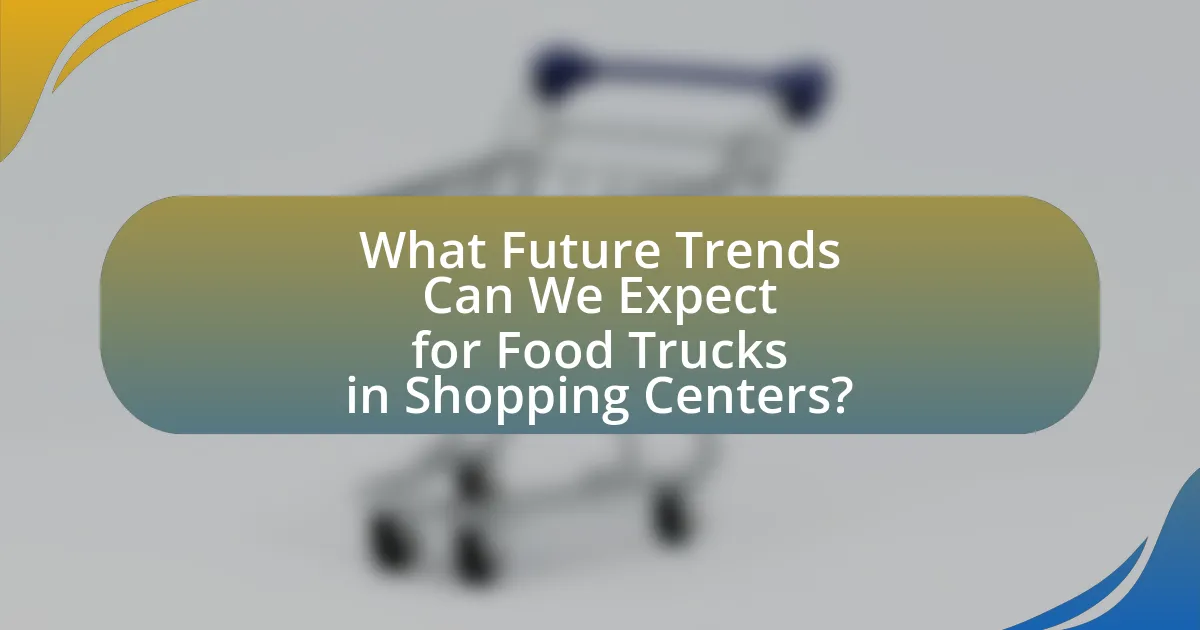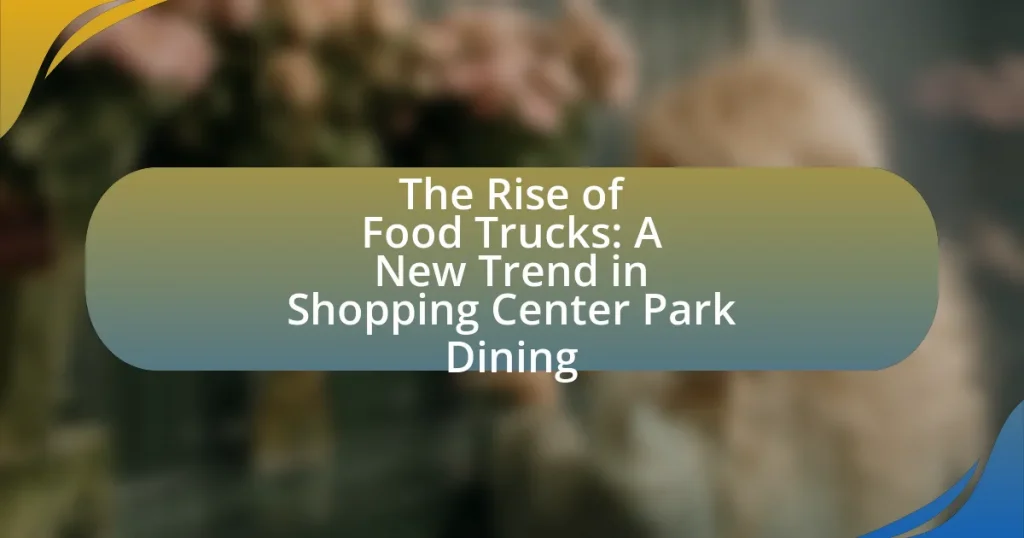The article examines the rise of food trucks in shopping center park dining, highlighting a significant shift in consumer preferences towards diverse, convenient, and affordable food options. It discusses how food trucks enhance the shopping experience by providing unique culinary offerings and fostering community engagement. Key factors contributing to their popularity include lower costs, mobility, and the ability to cater to various dietary preferences. The article also addresses challenges faced by food trucks, such as regulatory restrictions and competition, while exploring future trends and innovations that may shape the industry.

What is the Rise of Food Trucks in Shopping Center Park Dining?
The rise of food trucks in shopping center park dining represents a significant shift in consumer dining preferences, driven by the demand for diverse, convenient, and affordable food options. Food trucks offer a unique culinary experience, allowing shoppers to enjoy a variety of cuisines in a casual outdoor setting, which enhances the overall shopping experience. According to a report by IBISWorld, the food truck industry has grown at an annual rate of 7.5% over the past five years, indicating a strong consumer interest in this dining format. This trend is further supported by the increasing number of shopping centers incorporating food truck parks as a way to attract visitors and create a vibrant community atmosphere.
How have food trucks transformed the dining experience in shopping centers?
Food trucks have transformed the dining experience in shopping centers by providing diverse, convenient, and affordable food options. This shift allows shoppers to enjoy a variety of cuisines without the need for traditional sit-down restaurants, enhancing the overall shopping experience. According to a report by IBISWorld, the food truck industry has grown significantly, with revenue reaching approximately $1 billion in the United States, indicating a strong consumer preference for this dining format. Additionally, food trucks often feature local and gourmet offerings, attracting customers seeking unique culinary experiences while shopping.
What factors contributed to the popularity of food trucks in these locations?
The popularity of food trucks in shopping center park locations is primarily driven by their affordability, convenience, and diverse food offerings. Food trucks typically have lower overhead costs compared to traditional restaurants, allowing them to offer competitive pricing, which attracts budget-conscious consumers. Additionally, their mobility enables them to reach various locations, catering to different customer bases and events, thus enhancing accessibility. The variety of cuisines available from food trucks also appeals to a wide range of tastes, making them a popular choice for diners seeking unique and diverse culinary experiences. These factors collectively contribute to the growing trend of food trucks in these specific dining environments.
How do food trucks enhance the overall shopping experience for customers?
Food trucks enhance the overall shopping experience for customers by providing convenient access to diverse food options directly within shopping areas. This accessibility allows shoppers to enjoy meals without leaving the premises, thereby increasing their time spent at the shopping center. Additionally, food trucks often feature unique and gourmet offerings that cater to various dietary preferences, which can attract a wider range of customers. According to a study by the National Restaurant Association, 70% of consumers are more likely to visit a shopping center that offers food trucks, indicating that these mobile eateries significantly contribute to customer satisfaction and engagement during their shopping trips.
Why are food trucks becoming a preferred dining option?
Food trucks are becoming a preferred dining option due to their convenience, diverse menu offerings, and affordability. These mobile kitchens allow customers to access a variety of cuisines in easily accessible locations, often with shorter wait times compared to traditional restaurants. According to a 2021 report by IBISWorld, the food truck industry has grown significantly, with revenue increasing by 7.5% annually over the past five years, indicating a rising consumer preference for this dining format. Additionally, food trucks often have lower overhead costs than brick-and-mortar establishments, enabling them to offer competitive pricing, which appeals to budget-conscious diners.
What advantages do food trucks offer over traditional restaurants?
Food trucks offer several advantages over traditional restaurants, including lower startup costs, flexibility in location, and a diverse menu. The lower startup costs for food trucks, which can range from $20,000 to $100,000, compared to the average $250,000 to $500,000 for a traditional restaurant, allow entrepreneurs to enter the food industry with less financial risk. Additionally, food trucks can operate in various locations, adapting to customer demand and events, which enhances their visibility and customer reach. Furthermore, food trucks often feature a rotating menu that allows them to experiment with different cuisines and cater to diverse tastes, attracting a broader customer base. These factors contribute to the growing popularity of food trucks in urban dining landscapes.
How do food trucks cater to diverse culinary preferences?
Food trucks cater to diverse culinary preferences by offering a wide variety of cuisines that reflect different cultural backgrounds and dietary needs. This adaptability allows food trucks to serve everything from traditional street food to gourmet dishes, accommodating vegetarian, vegan, gluten-free, and ethnic options. For instance, a study by the National Restaurant Association indicates that 70% of consumers are more likely to visit food trucks that offer unique or diverse menu items. This flexibility not only attracts a broad customer base but also enables food trucks to quickly respond to changing food trends and local tastes, ensuring they meet the demands of a diverse clientele.
What challenges do food trucks face in shopping center parks?
Food trucks face several challenges in shopping center parks, primarily including limited space, regulatory restrictions, and competition. Limited space often restricts the number of food trucks that can operate simultaneously, leading to overcrowding and reduced customer access. Regulatory restrictions, such as permits and health codes, can complicate operations and increase costs for food truck owners. Additionally, competition from established restaurants within the shopping center can diminish customer foot traffic to food trucks, impacting their sales. These challenges highlight the complexities food trucks encounter in navigating the shopping center park environment.
How do regulations impact the operation of food trucks in these areas?
Regulations significantly impact the operation of food trucks by dictating where they can operate, the types of food they can serve, and the permits required for compliance. Local health codes often require food trucks to meet specific sanitation standards, which can limit their ability to operate in certain areas without proper facilities. For instance, cities may enforce zoning laws that restrict food trucks from parking in high-traffic areas or near established restaurants, thereby affecting their customer reach. Additionally, the necessity for business licenses and health permits can create financial and bureaucratic barriers that may deter new entrants into the food truck market. These regulations are designed to ensure public safety and fair competition, but they can also constrain the flexibility and mobility that food trucks typically offer.
What logistical issues do food truck owners encounter?
Food truck owners encounter several logistical issues, including location permits, supply chain management, and vehicle maintenance. Securing permits for operating in specific locations can be challenging due to varying regulations across municipalities, which can hinder business operations. Additionally, managing inventory and sourcing fresh ingredients requires efficient supply chain logistics, as food trucks often operate in different locations daily. Vehicle maintenance is also critical, as breakdowns can lead to lost revenue and operational delays. These factors collectively impact the efficiency and profitability of food truck businesses.

How do Food Trucks Influence Consumer Behavior?
Food trucks influence consumer behavior by providing convenient, diverse, and often unique dining options that attract customers seeking quick meals and novel culinary experiences. Their mobility allows them to reach various locations, creating a sense of spontaneity and excitement around food choices. Research indicates that food trucks often cater to local tastes and trends, enhancing their appeal; for instance, a study published in the Journal of Foodservice Business Research found that food trucks significantly impact consumer preferences by offering gourmet options at lower prices compared to traditional restaurants. This combination of accessibility, variety, and affordability drives increased foot traffic and encourages consumers to explore new flavors, ultimately shaping their dining habits and preferences.
What role do food trucks play in attracting foot traffic to shopping centers?
Food trucks significantly enhance foot traffic to shopping centers by providing diverse and convenient dining options that appeal to a wide range of customers. Their presence creates a vibrant atmosphere, attracting both food enthusiasts and shoppers who may not have visited otherwise. According to a study by the National Restaurant Association, 60% of consumers are more likely to visit a shopping center that offers food trucks, indicating their effectiveness in drawing crowds. Additionally, food trucks often host events or collaborate with local businesses, further increasing visibility and engagement within the shopping center.
How do food trucks create a sense of community among shoppers?
Food trucks create a sense of community among shoppers by fostering social interactions and shared experiences in a casual dining environment. The presence of food trucks encourages people to gather in communal spaces, where they can enjoy diverse culinary offerings while engaging in conversations with friends, family, and even strangers. This social dynamic is supported by the fact that food trucks often participate in local events and festivals, which further enhances community engagement. Additionally, the variety of food options available from different trucks caters to diverse tastes, allowing shoppers to bond over shared meals and culinary discoveries, thereby strengthening community ties.
What marketing strategies do food trucks use to engage customers?
Food trucks engage customers through a combination of social media marketing, location-based promotions, and unique branding. Social media platforms like Instagram and Facebook allow food trucks to showcase their menu items, share customer experiences, and announce their locations in real-time, effectively reaching a wider audience. Additionally, food trucks often utilize location-based promotions, such as participating in local events or collaborating with shopping centers, to attract foot traffic. Unique branding, including eye-catching designs and themed menus, helps food trucks stand out in a competitive market, fostering customer loyalty and repeat visits. These strategies have proven effective, as food trucks have seen significant growth, with the industry projected to reach $1 billion in revenue by 2024, according to IBISWorld.
How do food trucks adapt to changing consumer preferences?
Food trucks adapt to changing consumer preferences by diversifying their menus, incorporating local and seasonal ingredients, and responding to dietary trends. For instance, many food trucks now offer vegan, gluten-free, and organic options to cater to health-conscious consumers. Additionally, food trucks often engage with customers through social media to gather feedback and adjust their offerings accordingly. This responsiveness is supported by data indicating that 60% of consumers prefer food options that reflect their dietary needs and preferences, demonstrating the importance of adaptability in the food truck industry.
What trends are emerging in food truck menus?
Emerging trends in food truck menus include a focus on plant-based options, global cuisines, and fusion dishes. Food trucks are increasingly offering vegan and vegetarian meals to cater to the growing demand for healthier and sustainable eating, with a report from the Plant Based Foods Association indicating a 27% increase in plant-based food sales in the past year. Additionally, food trucks are embracing diverse global flavors, reflecting consumer interest in authentic international cuisine, as seen in the rise of Korean BBQ and Mexican street food offerings. Fusion dishes, which combine elements from different culinary traditions, are also gaining popularity, allowing food trucks to create unique and innovative menu items that attract adventurous eaters.
How do food trucks incorporate local ingredients into their offerings?
Food trucks incorporate local ingredients into their offerings by sourcing produce, meats, and dairy from nearby farms and markets. This practice not only supports local agriculture but also enhances the freshness and flavor of the food served. For instance, many food trucks establish partnerships with local farmers, ensuring that seasonal ingredients are used, which can lead to menu changes that reflect the harvest. Additionally, studies show that using local ingredients can reduce transportation costs and environmental impact, making food trucks a sustainable dining option.

What Future Trends Can We Expect for Food Trucks in Shopping Centers?
Food trucks in shopping centers are expected to increasingly focus on diverse culinary offerings and enhanced customer experiences. As consumer preferences shift towards unique and gourmet food options, shopping centers will likely feature food trucks that provide a variety of international cuisines and health-conscious choices. Additionally, the integration of technology, such as mobile ordering and contactless payments, will streamline the purchasing process, making it more convenient for shoppers.
Research indicates that food trucks can drive foot traffic to shopping centers, with a study by the National Restaurant Association showing that 60% of consumers are more likely to visit a shopping center with food trucks. This trend is further supported by the growing popularity of food truck festivals and events, which attract large crowds and create a vibrant atmosphere. As a result, shopping centers may increasingly incorporate designated food truck areas to capitalize on this trend, enhancing the overall shopping experience.
How might technology impact the food truck industry in shopping centers?
Technology will significantly enhance the food truck industry in shopping centers by streamlining operations and improving customer engagement. For instance, mobile apps can facilitate online ordering and payment, reducing wait times and increasing customer satisfaction. Additionally, GPS tracking technology allows customers to locate food trucks easily, enhancing foot traffic to these vendors. According to a report by IBISWorld, the food truck industry has seen a growth rate of 7.5% annually, partly due to technological advancements that improve service efficiency and customer interaction. Furthermore, social media platforms enable food trucks to market their locations and menu offerings in real-time, driving customer interest and loyalty.
What innovations are food trucks adopting to enhance customer experience?
Food trucks are adopting innovations such as mobile ordering apps, contactless payment systems, and enhanced menu customization to enhance customer experience. Mobile ordering apps allow customers to place orders in advance, reducing wait times and improving convenience. Contactless payment systems streamline transactions, making them faster and safer, especially in a post-pandemic environment. Enhanced menu customization options enable customers to tailor their meals according to personal preferences, fostering a more personalized dining experience. These innovations collectively contribute to a more efficient and enjoyable interaction between food trucks and their customers.
How could sustainability practices shape the future of food trucks?
Sustainability practices could significantly shape the future of food trucks by promoting eco-friendly operations and reducing waste. Food trucks that adopt practices such as using biodegradable packaging, sourcing local ingredients, and implementing energy-efficient cooking methods can attract environmentally conscious consumers. For instance, a study by the National Restaurant Association found that 60% of consumers are more likely to choose a restaurant that offers sustainable options. Additionally, food trucks that utilize solar panels or electric vehicles can lower their carbon footprint, aligning with the growing demand for sustainable dining experiences. This shift not only enhances brand loyalty but also positions food trucks as leaders in the evolving food industry focused on sustainability.
What best practices should food truck operators follow in shopping centers?
Food truck operators in shopping centers should prioritize compliance with local regulations and permits. Adhering to health codes, obtaining necessary licenses, and following zoning laws ensures legal operation and builds trust with customers. Additionally, food truck operators should establish strong relationships with shopping center management to secure prime locations and understand foot traffic patterns. Effective marketing strategies, such as social media engagement and promotions, can attract customers and enhance visibility. Finally, maintaining high food quality and excellent customer service fosters repeat business and positive word-of-mouth, which are crucial for success in competitive environments like shopping centers.
How can food trucks effectively collaborate with shopping center management?
Food trucks can effectively collaborate with shopping center management by establishing clear communication and mutually beneficial agreements. This collaboration can include scheduling regular food truck events that align with shopping center promotions, thereby increasing foot traffic for both parties. Additionally, food trucks can offer unique culinary experiences that complement the shopping center’s offerings, attracting diverse customer demographics. According to a study by the National Association of Food Trucks, 70% of shopping centers reported increased customer engagement when food trucks were present, demonstrating the positive impact of such partnerships.
What tips can food truck owners implement to maximize their success?
Food truck owners can maximize their success by focusing on strategic location selection, menu innovation, and effective marketing. Choosing high-traffic areas, such as shopping centers or events, increases visibility and customer access, which is crucial for sales. Menu innovation, including seasonal offerings and unique dishes, attracts diverse customers and encourages repeat business. Effective marketing through social media platforms and local partnerships enhances brand awareness and customer engagement. According to a report by IBISWorld, the food truck industry has grown significantly, with revenue reaching approximately $1 billion in 2021, highlighting the potential for success when these strategies are implemented.















